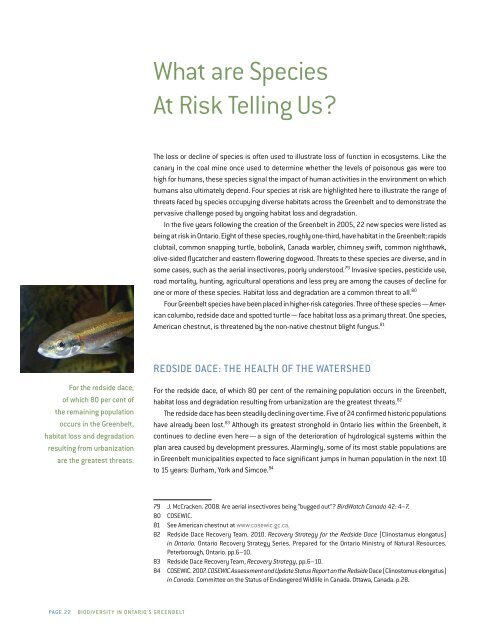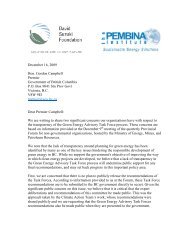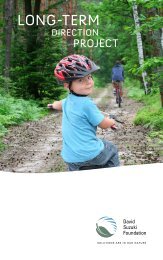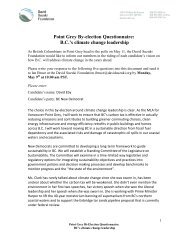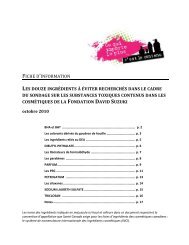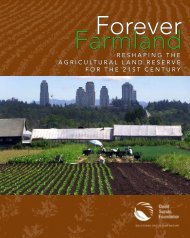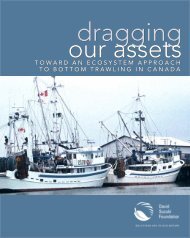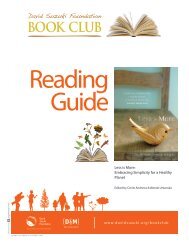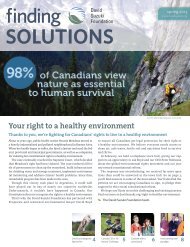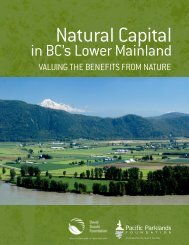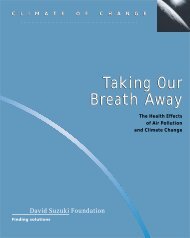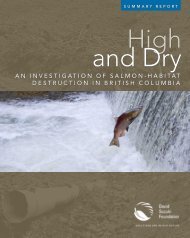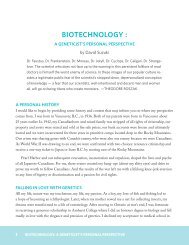Biodiversity in Ontario's Greenbelt (PDF) - David Suzuki Foundation
Biodiversity in Ontario's Greenbelt (PDF) - David Suzuki Foundation
Biodiversity in Ontario's Greenbelt (PDF) - David Suzuki Foundation
You also want an ePaper? Increase the reach of your titles
YUMPU automatically turns print PDFs into web optimized ePapers that Google loves.
What are Species<br />
At Risk Tell<strong>in</strong>g Us<br />
The loss or decl<strong>in</strong>e of species is often used to illustrate loss of function <strong>in</strong> ecosystems. Like the<br />
canary <strong>in</strong> the coal m<strong>in</strong>e once used to determ<strong>in</strong>e whether the levels of poisonous gas were too<br />
high for humans, these species signal the impact of human activities <strong>in</strong> the environment on which<br />
humans also ultimately depend. Four species at risk are highlighted here to illustrate the range of<br />
threats faced by species occupy<strong>in</strong>g diverse habitats across the <strong>Greenbelt</strong> and to demonstrate the<br />
pervasive challenge posed by ongo<strong>in</strong>g habitat loss and degradation.<br />
In the five years follow<strong>in</strong>g the creation of the <strong>Greenbelt</strong> <strong>in</strong> 2005, 22 new species were listed as<br />
be<strong>in</strong>g at risk <strong>in</strong> Ontario. Eight of these species, roughly one-third, have habitat <strong>in</strong> the <strong>Greenbelt</strong>: rapids<br />
clubtail, common snapp<strong>in</strong>g turtle, bobol<strong>in</strong>k, Canada warbler, chimney swift, common nighthawk,<br />
olive-sided flycatcher and eastern flower<strong>in</strong>g dogwood. Threats to these species are diverse, and <strong>in</strong><br />
some cases, such as the aerial <strong>in</strong>sectivores, poorly understood. 79 Invasive species, pesticide use,<br />
road mortality, hunt<strong>in</strong>g, agricultural operations and less prey are among the causes of decl<strong>in</strong>e for<br />
one or more of these species. Habitat loss and degradation are a common threat to all. 80<br />
Four <strong>Greenbelt</strong> species have been placed <strong>in</strong> higher-risk categories. Three of these species — American<br />
columbo, redside dace and spotted turtle — face habitat loss as a primary threat. One species,<br />
American chestnut, is threatened by the non-native chestnut blight fungus. 81<br />
Redside dace: The health of the watershed<br />
For the redside dace,<br />
of which 80 per cent of<br />
the rema<strong>in</strong><strong>in</strong>g population<br />
occurs <strong>in</strong> the <strong>Greenbelt</strong>,<br />
habitat loss and degradation<br />
result<strong>in</strong>g from urbanization<br />
are the greatest threats.<br />
For the redside dace, of which 80 per cent of the rema<strong>in</strong><strong>in</strong>g population occurs <strong>in</strong> the <strong>Greenbelt</strong>,<br />
habitat loss and degradation result<strong>in</strong>g from urbanization are the greatest threats. 82<br />
The redside dace has been steadily decl<strong>in</strong><strong>in</strong>g over time. Five of 24 confirmed historic populations<br />
have already been lost. 83 Although its greatest stronghold <strong>in</strong> Ontario lies with<strong>in</strong> the <strong>Greenbelt</strong>, it<br />
cont<strong>in</strong>ues to decl<strong>in</strong>e even here — a sign of the deterioration of hydrological systems with<strong>in</strong> the<br />
plan area caused by development pressures. Alarm<strong>in</strong>gly, some of its most stable populations are<br />
<strong>in</strong> <strong>Greenbelt</strong> municipalities expected to face significant jumps <strong>in</strong> human population <strong>in</strong> the next 10<br />
to 15 years: Durham, York and Simcoe. 84<br />
79 J. McCracken. 2008. Are aerial <strong>in</strong>sectivores be<strong>in</strong>g “bugged out” BirdWatch Canada 42: 4–7.<br />
80 COSEWIC.<br />
81 See American chestnut at www.cosewic.gc.ca.<br />
82 Redside Dace Recovery Team. 2010. Recovery Strategy for the Redside Dace (Cl<strong>in</strong>ostamus elongatus)<br />
<strong>in</strong> Ontario. Ontario Recovery Strategy Series. Prepared for the Ontario M<strong>in</strong>istry of Natural Resources.<br />
Peterborough, Ontario. pp.6–10.<br />
83 Redside Dace Recovery Team, Recovery Strategy, pp.6–10.<br />
84 COSEWIC. 2007. COSEWIC Assessment and Update Status Report on the Redside Dace (Cl<strong>in</strong>ostomus elongatus)<br />
<strong>in</strong> Canada. Committee on the Status of Endangered Wildlife <strong>in</strong> Canada. Ottawa, Canada. p.28.<br />
Page 22<br />
<strong>Biodiversity</strong> <strong>in</strong> Ontario’s greenbelt


